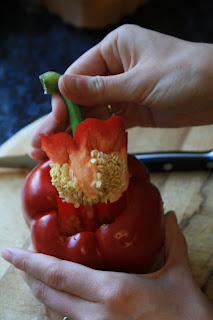
My family had the most internationally influenced food of anyone I knew growing up, second only maybe to those who had emigrated from another country. We would have stir fry, black beans and rice, meat and potatoes, schnitzel, lasagne, fondue, and stuffed peppers among other things. I never knew that these dishes all had different food heritage and this was all very normal to me. Once I started to make my own food and tried to find recipes to recreate some of these dinner staples in my household, I learned how worldly the selection was. OK, not everything was authentic and maybe the recipes were tweaked to suit our tastes, but still, for a family from the Midwest that grew up on (red) meat and potatoes, we were the pioneers of cultural expansion through food in my eyes.
Two examples spring to mind that are somewhat relevant. One Thanksgiving, a traditional time of eating very American foods like turkey, potatoes and apple pie, my mom had some of her Chinese students and friends from graduate school over as they had no where to go for the day. In return for the hospitality, they showed us how to make authentic Chinese eggrolls from scratch. It's a really fun memory for a four year old to have of carefully rolling the wraps and sealing with egg, then hearing the eggrolls cook in hot oil.
The other memory is from high school. We had three acres of land at the time and we grew a lot of vegetables. My dad always planted tomatoes and we would can and freeze most of them to eat throughout the year, as we did with the beans, peppers, peas, squash and apples that were the main staples of the garden. Taking the garden produce as a cue, I decided to have a party. A usual pizza and music party like other 17 year olds? No, I had an Italian food themed party, including caprese salad, a frittata, pasta with fresh vegetables and lots of tomatoes, complete with a table outside on the porch to give the party an Italian summer feel.
The other day, I decided the I wanted to make stuffed peppers, one of my favorite dishes growing up and one I would request to have made on my birthday (that, and lasagne). I told my fiance what we were having for dinner and he perked up, thinking I was making the Greek stuffed peppers dish. What? I had no idea this was a Greek dish too! I looked up the recipe in the Greek cookbook I have and the funny thing is that the recipes are very similar to a point. The Greek recipes calls for the seminal ingredients of any good Greek dish, tomatoes and cinnamon, while mine does not. Still, I think it is interesting that we have been eating almost the same dish thousands of miles apart for so many years. Maybe, if everyone had access to all the food ingredients out there, we would all come up with generally the same dishes, like when pre-historic humans all created art at the same time across the world. Maybe all people do crave similar textures and tastes in food.
Below is what I did for my recipe of stuffed peppers, but at the end I will also include the Greek variations.
I sauteed some (about 500 grams) mince meat and half an onion, then threw in chopped mushrooms and courgettes. You can also add any extra peppers or leave all veggies out.
While the meat mixture is cooking, I cut up the peppers for stuffing. This is a very particular way to cut them so that only the top comes off. You start by cutting around the stem but not too deeply or you will have holes in your pepper!
Pull out the stem and clean out any seeds by washing it out with water- much easier than getting seeds one by one.
Pretty hollow peppers.
Add rice and water to the meat mixture. I usually have a 2/3 rice to 1/3 meat ratio, but it depends how meaty you are feeling to how much rice you add.
While the rice/meat mixture is cooking, bring a large pot of water to boil for the peppers. Place all the peppers in the pan, submerged with water, for which I use tongs of some sort that I can find.
After only 7 or so minutes, or until the peppers are tender but not falling apart, drain the water from the pot and each pepper, pull the peppers out and place in an oven-proof dish.

Now that the rice mixture is done, fill the peppers! Don't be shy, fill them to the brim!
When all the peppers are full, place them in a hot oven (maybe 180C, 250 F?) for about 15 minutes, then top with cheddar cheese.
In the Greek version of this dish, you do not add veggies and Worcestershire sauce to the rice mixture and should add cinnamon and chopped tomatoes instead. You can also stuff practically anything- courgette, pepper, tomato, aubergine. If you can hollow it, you can stuff it.
I think this is truly a dish that comes from both the (now) Greek and American food sides of me, without even knowing it all those years.






















